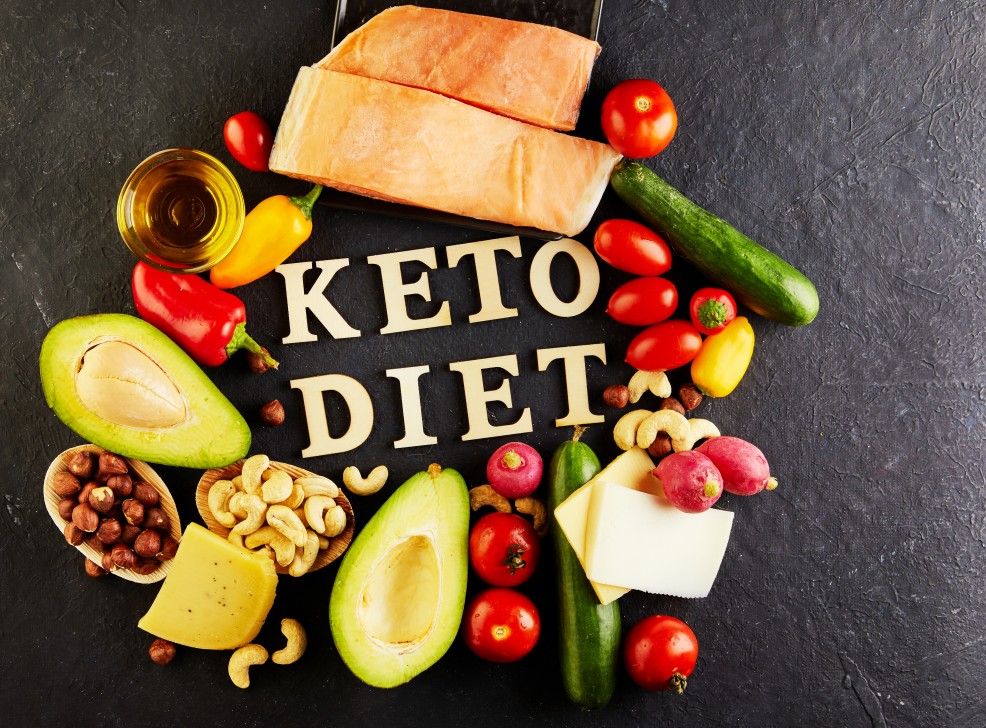CARB INTAKE
Most of the carbs should come from non-starchy vegetables
Green, fibrous vegetables are your best choices, though many other low carb vegetables are fine
Always accompany a carb with either a fat or a protein
NET CARBS
The Ketogenic diet only counts Net Carbs as fiber content in food decreases the overall carb content’s ability to impact blood sugars
Net Carb Formula: Total Carb Count of a Food Minus Fiber Count
LOTS OF HEALTHY FATS
In ketosis, fat is the main energy source for the body
Fats provide satiety, boost metabolism and support the enjoyment of food
Provide key macronutrient requirements
Natural fats are fine when reducing carbs
The best fats are monounsaturated and saturated, including olive oil, grass fed butter, and coconut oil
Margarine is never advised, as it is fake and interferes with ketosis
Limit intake of polyunsaturated fats, including soybean oil, corn oil, and cottonseed oil
Fat intake is variable and depends on weight loss goals
It is not advisable to eat so much fat that you send your caloric intake through the roof
WHEN IN DOUBT, EAT LESS CARBS AND MORE FAT
Daily Fat Intake Guidelines
These will vary by body size
2 to 3 eggs
1 to 2 tablespoons of butter
2 tablespoons of heavy cream
2 tablespoons of olive oil when cooking or for salad dressings
2 ounces of cheese
4 to 6 ounces of meat, chicken, seafood, or fish at each meal
½ an avocado or 10 olives
1 to 2 ounces of nuts or seeds
Use canola, peanut and grapeseed oils for pan cooking and stir-frys
Use full fat mayonnaise, canola oil mayo is a good choice
1 tablespoon of coconut oil contains ketosis boosting MCTs (medium chain triglycerides)
Avoid low fat foods, including reduced fat dairy as they have carbohydrates, and chemical compounds
ADEQUATE PROTEIN
Protein is both 46% ketogenic and 58% anti-ketogenic, as some protein will convert to glucose in the bloodstream and inhibit ketosis, so intake should be enough to prevent muscle loss, but not so much that will disrupt ketosis.
General Protein Intake Guidelines
Sedentary lifestyle: 0.69 – 0.8 grams per pound of lean body mass
Mildly active: 0.8 to 1 gram per pound of lean body mass
Heavy strength training/bodybuilding and exercise: 1 to 1.2 grams per pound of lean body mass
Lean body mass is typically defined as – body weight minus body fat. You can use any of a number of online lean body mass calculators, such as this one – http://www.calculator.net/lean-body-mass-calculator.html to figure yours.
Protein Choices
Fatty red meats
Chicken with skin
Turkey
Eggs
Deli meats
Seafood
Fish
Pork
Veal
Lamb
Fowl (duck, goose, hen, quail)
Organ meats (tongue brains, liver, heart, and kidneys)
Game meats (ostrich, venison, caribou, bison, and elk)
Eggs
Nuts, seeds and full fat dairy in moderation as they do contain some carbs
EAT TO SATISFACTION
Eat when hungry until you feel satisfied, but not stuffed
INCREASE SALT INTAKE
A little extra salt can help avoid possible side effects as your body adjusts to ketosis, including headaches, muscle cramps, or weakness that occurs as result of an electrolyte imbalance and since a low carb diet is naturally diuretic, you don’t have to avoid salt to minimize water retention.
Get that salt from 1 to 2 cups of broth daily or soy sauce over food
Caution: ask your doctor about increasing salt, and if you are being treated for a condition that requires limited sodium intake, like hypertension continue with the medical advice of your doctor.
DRINK LOTS OF WATER
Water is a natural appetite suppressant
Supports the body’s ability to metabolize fat
Several studies found that reducing intake of water might cause fat deposits to increase, while drinking more reduces them
Hydration greatly promotes weight loss, so drink lots of fresh water throughout the day
The more active you are the more hydration you will need


